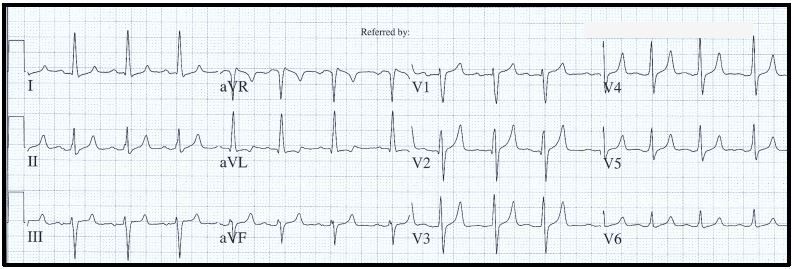Hyperkalemia in a Young Woman with Type 1 Diabetes Mellitus
Hyperkalemia is the most serious of the electrolyte disorders and can lead to death if not managed appropriately.
Figure 1. Wide QRS complex, 70 bpm. (Click on images to enlarge)

Figure 2. Wide QRS complex, regular, ~70 bpm.

Figure 3.

Table.

A 32-year-old woman with multiple medical problems was brought to the emergency department with lethargy and weakness. The family noted progressive confusion and fatigue over 2 days, coupled with extreme weakness. The patient and family denied all other complaints as well as any traumatic or toxicologic events. The medical history included juvenile-onset diabetes mellitus, hypertension, renal insufficiency, and diabetic retinopathy with visual impairment; the patient used insulin and lisinopril as well as several other unknown medications.
On examination, she was confused and lethargic but was aroused by stimuli and spoke coherently. Vital signs were: blood pressure, 188/106 mmHg; pulse, approximately 70 beats/min; respiratory rate, 24 breaths/min; temperature, 36.1°C (97°F); and oxygen saturation, 94% on room air; the ECG monitor demonstrated the rhythm strip in Figure 1. A bedside glucose test was 256 mg/dL. The remainder of the examination was unremarkable. Results of a 12-lead ECG are seen in Figure 2.
Based upon the ECG findings noted in Figures 1 and 2, which of the following best describe the patient’s risk of an adverse event and the most appropriate management:
A. Low risk; atropine IV and glucagon IV
B. Intermediate risk; transcutaneous pacing and IV epinephrine infusion
C. High risk; synchronized electrical cardioversion with amiodarone IV
D. Extremely high risk; calcium IV, sodium bicarbonate IV, and dextrose/insulin IV
Correct Answer: D. Extremely high risk; calcium IV, sodium bicarbonate IV, and dextrose/insulin IV
Discussion
Hyperkalemia presents across a spectrum of severity, ranging from asymptomatic discovery to cardiorespiratory arrest. Of the various electrolyte disorders, it is perhaps the most serious with the potential for severe adverse outcomes-including death-if not managed appropriately. Common causes of hyperkalemia include acute and chronic kidney injury, red blood cell hemolysis, diabetic ketoacidosis and other acidotic states, medication-related issues, and excessive dietary supplementation (ie, the salt substitute).
Modest increases in the serum potassium enhance or accentuate myocardial repolarization which is manifested electrocardiographically by alterations in the T wave (Figure 3, above). Note the peaked, or prominent, T waves in the precordial leads that are the most common ECG findings of significant hyperkalemia. Continued increase in the serum potassium will affect the cardiac electrical system, including both pacemaker and conduction system functions; hyperkalemia depresses native pacemaker function and produces a slowing of cardiac conduction. Amplitude of the P wave will decrease early in the process. At progressively higher serum levels, the QRS complex widens (Figure 2), at times resembling a bundle branch block; QRS complex widening, ranging from minimal to maximal, is an ominous finding and suggests cardiotoxicity. Eventually, the QRS complex blends with the T wave, forming a “sine-wave,” or sinusoidal, structure on the ECG; the P wave is no longer apparent on the ECG; despite the electrocardiographic disappearance of the P wave, however, sinus rhythm continues with maintained sinus node activity. This rhythm is termed the sinoventricular rhythm of severe hyperkalemia. Progressive increase of the potassium level eventually results in ventricular fibrillation and/or asystole.
Management
The management of hyperkalemia is guided in large part by the patient’s clinical situation and the ECG findings. The goals of therapy include stabilization of the myocardial cell membrane, transient shifting of potassium from the vascular space to the intracellular space, and removal of the potassium permanently from the body (Table, above). Both cellular membrane stabilization and internal shifting are transient events; repeat medication administration(s) may be necessary in patients with significant ECG abnormality while awaiting removal therapies, including hemodialysis. ECG response to therapy is often prompt with visualization noted on the ECG.
Case Conclusion
The ECG findings in Figures 1 and 2 were suspicious for hyperkalemia, specifically the sinoventricular rhythm of severe hyperkalemia. While appropriate therapy was initiated, a point-of-care test revealed a serum potassium level of 8.2 mEq/dL. Medical treatment included cardiac monitoring with IV calcium, IV sodium bicarbonate, IV insulin (regular), IV dextrose 50%, and albuterol nebulized. The QRS complex markedly narrowed over approximately 5 minutes after treatment commenced with return of normal sinus rhythm with prominent T waves. Nephrology was consulted to evaluate the patient for hemodialysis. While awaiting hemodialysis, the patient required retreatment with the medications noted above. The patient was admitted to the hospital with plans for initiation of hemodialysis. She was discharged 5 days later after surgical placement of the arteriovenous fistula (AVF); a temporary central venous catheter was placed for hemodialysis until maturation of the AVF.
Take-home Points
1. The sinoventricular rhythm of severe hyperkalemia is a life-threatening rhythm, requiring urgent treatment.
2. The sinoventricular rhythm is characterized by a very wide QRS complex that occurs at a very slow ventricular rate.
3. Management should be initiated based on the clinical presentation and ECG findings prior to laboratory confirmation of hyperkalemia.
4. The impact of medication-based treatment is often transient; repeat therapy is frequently needed while awaiting definitive care with hemodialysis.
References:
Brady WJ, Hudson K, Naples R, et al (eds). The ECG in Prehospital Emergency Care. London, England: John Wiley & Sons; 2012.